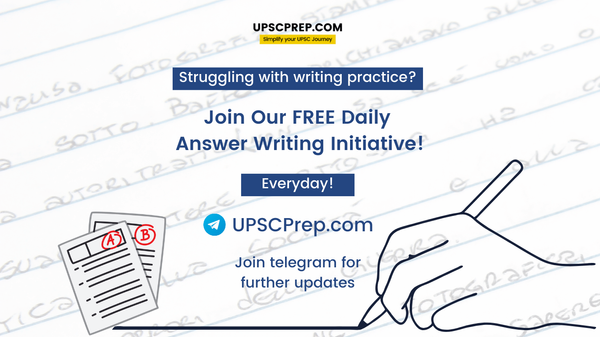Table of contents
Subject: GS 1
Syllabus: Indian Society
Questions
- The RAISE (Responsible AI for Social Empowerment) 2020 summit has brought issues around Artificial Intelligence (AI) to the centre of policy discussions. In this background, elucidate the multidimensional effects AI would create on society. (250 words, 15 marks)
- Improved availability of assistive aids and accessibility to social infrastructure is necessary to ensure improvements in the lives of the specially-abled (divyang) persons. Discuss. (250 words, 15 marks)
Download Model Structures PDF
Model Structures
Q1. The RAISE (Responsible AI for Social Empowerment) 2020 summit has brought issues around Artificial Intelligence (AI) to the centre of policy discussions. In this background, elucidate the multidimensional effects AI would create on society. (250 words, 15 marks)
Introduction
- It’s estimated artificial intelligence (AI) will add as much as $15.7 trillion (more than Rs 1214 lakh crore) to the global economy by 2030. RAISE 2020 will be a global meeting of minds to exchange ideas and chart a course for using AI for social transformation, inclusion and empowerment in areas like Healthcare, Agriculture, Education and Smart Mobility, among other sectors.
Main Body:
- Impact of Artificial Intelligence on society:
- India is well-positioned to become a global leader in the development of artificial intelligence. Industry analysts predict that AI could add up to $957 billion to India’s economy by 2035.
- From agriculture to fin-tech and healthcare to infrastructure, artificial intelligence can be a truly transformative force. India is uniquely positioned to become the AI laboratory of the world and contribute to inclusive development and growth through empowerment.
- The Summit aims to help create a data-rich environment, which is a stepping stone to eventually transforming lives globally.
- RAISE 2020 is a first-of-its-kind, global meeting of minds on Artificial Intelligence to drive India's vision and roadmap for social transformation, inclusion and empowerment through responsible AI.
- Challenges:
- Advanced nations vs developing nations: If current trends continue, much of this new wealth will be owned and controlled by corporations and individuals based in China and the United States, as well as by the national governments that represent them.
- But technological superiority by great powers undermines the positive potential of AI for the majority of the world’s population, particularly in developing economies.
- The US and China account for more than 94 per cent of funding for AI startups over the past five years and half of the world’s hyper-scale data centres.
- The two countries possess roughly 90 per cent of the market capitalisation of the world’s 70 largest digital platforms, controlling a large proportion of cross-border data flows.
- The nations that own and control AI platforms and the data that powers them stand to dominate the global economy for decades to come.
- Experts in the field are also mostly from developed economies. They enjoy a disproportionate representation in the industry bodies that develop the standards and technical protocols that shape the international regulations for AI, often at the expense of the differing needs of developing economies.
- Lacks coordination: Over 160 sets of AI ethics and governance frameworks have so far been developed by policymakers, think tanks, and activists. Still, there are no platforms to coordinate these initiatives, or measures to ensure national governments align AI regulations and norms across international boundaries.
- The growing divide has implications for developing economies marginalized by the emerging AI sector.
- Measures to prevent domination of few in AI field:
- A recently released report from a working group convened by the Paris Peace Forum says an open, international dialogue on equitable AI governance could help set up global regulations.
- Governments of developing economies can remedy the widening imbalance between data providers and data collectors by creating incentives for foreign tech companies to invest in domestic research and development facilities to amplify local AI capabilities.
- It is also important to deter ‘brain drain’, where top experts leave their homes to pursue international opportunities, by promoting incentives such as funds for innovation and R&D to retain and further develop domestic talent.
Conclusion:
- In the spirit of ‘Sabka Saath Sabka Vikas’, honourable Prime Minister Shri Narendra Modi plans to leverage AI for inclusive development, representing the country's 'AI for All' strategy. Directed by the Prime Minister’s vision, India will soon stand out in the international community not just as a leader in the Artificial Intelligence field, but also as a model to show the world how to responsibly direct AI for social empowerment.
- The benefits of AI are plenty, but mitigating the potential harm is crucial. An international dialogue, focused on results, can create an equitable distribution of AI technologies.
Q2. Improved availability of assistive aids and accessibility to social infrastructure is necessary to ensure improvements in the lives of the specially-abled (divyang) persons. Discuss. (250 words, 15 marks)
Introduction
- The “Global Report on Assistive Technology, by the World Health Organisation and UNICEF, says: More than 2.5 billion people need one or more assistive products, such as wheelchairs, hearing aids, or apps that support communication and cognition and yet a billion of them are denied access, particularly in low- and middle-income countries, where access can be as low as 3% of the need for these life-changing products.
- The 2011 Census puts the national estimate of the number of people with disabilities at 2.21% of the total population (26.8 million persons), including persons with visual, hearing, speech, locomotor and mental disabilities with the majority in the 19-59 age group. The country’s disabled population increased by 22.4% between the 2001 and 2011 census periods; the total population increased by 17.6% however.
Main Body:
- What is Assistive Technology(AT)?
- Assistive technology(AT) is any item, piece of equipment, software program or product system that is used to increase, maintain or improve the functional capabilities of persons with disabilities.
- These include a very wide range of technologies and devices such as prosthetics, braces, walkers, special switches, special-purpose computers, screen readers and specialized curricular software. )
- Importance of Assistive Aids:
- Assistive technology is a life changer — it opens the door to education for children with impairments, employment and social interaction for adults living with disabilities, and independent life of dignity for older persons.
- a Large Number of People in Need of Assistive Products in Future: The number of people in need of one or more assistive products is likely to rise to 3.5 billion by 2050 due to the ageing population and the prevalence of non-communicable diseases rising across the world.
- Large Gaps in Service Provision and Trained Workforce: A survey of 70 countries found large gaps in service provision and trained workforce for assistive technology, especially in the domains of cognition, communication and self-care.
- It is estimated that approximately one in every 10 children in the world has a disability and less than 10% of children with disabilities in low-income countries go to school.
- Barriers to assistive products:
- Lack of assistive products:
- More than 2.5 billion people need one or more assistive products, such as wheelchairs, hearing aids, or apps that support communication and cognition.
- denying people access to these life-changing tools is not only an infringement of human rights.
- Barriers to access and coverage, in the context of AT, are best understood as the 5Ps:
- People Denied Assistive Products: A billion of them are denied access, particularly in low- and middle-income countries, where access can be as low as 3% of the need for these life-changing products.
- Products: Range, quality, affordability and supply of assistive products continue to be enormous challenges. Quality and standards issues such as safety, performance and durability are key concerns.
- Lack of coordination systems to facilitate information, referral, procurement and delivery of assistive products in humanitarian crises, particularly for children.
- Policy: A survey of more than 60 countries reported at least one government Ministry or authority responsible for access to AT with almost 90% having at least one piece of legislation on access to AT; however, current levels of access imply a long road to universal AT access.
- Poor implementation of policies and schemes hinders the inclusion of disabled persons. Though various acts and schemes have been laid down to empower the disabled, their enforcement faces many challenges.
- Lack of assistive products:
Way Forward:
- The Assistance to Disabled persons for purchasing/fitting of aids/appliances (ADIP) scheme is being implemented by the Ministry of Social Justice & Empowerment.
- It aims to assist the needy disabled persons in procuring durable, sophisticated and scientifically manufactured, modern, standard aids and appliances that can promote their physical, social and psychological rehabilitation, by reducing the effects of disabilities and enhancing their economic potential.
- People with disabilities need to be better integrated into society by overcoming stigma.
- Financing mechanisms are critical: loans, instalments or rebate system, including refurbishment and reuse of assistive products; the reduction and if possible, elimination of tariffs and taxes on internationally and locally produced and/or procured assistive products.
Conclusion:
- Thus with improved assistive technologies, the specially-abled can be provided with better opportunities and lead a quality life. For “Being disabled should not mean being disqualified from having access to every aspect of life.”

Write UnLimited Course (1 Year)
Write answers from any source, we will evaluate them for you.
